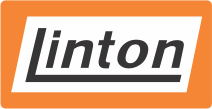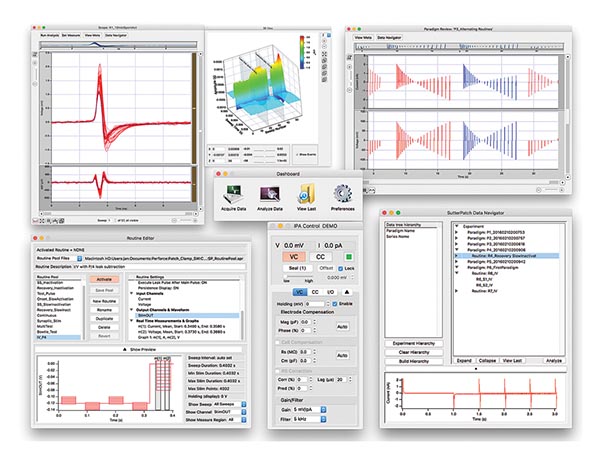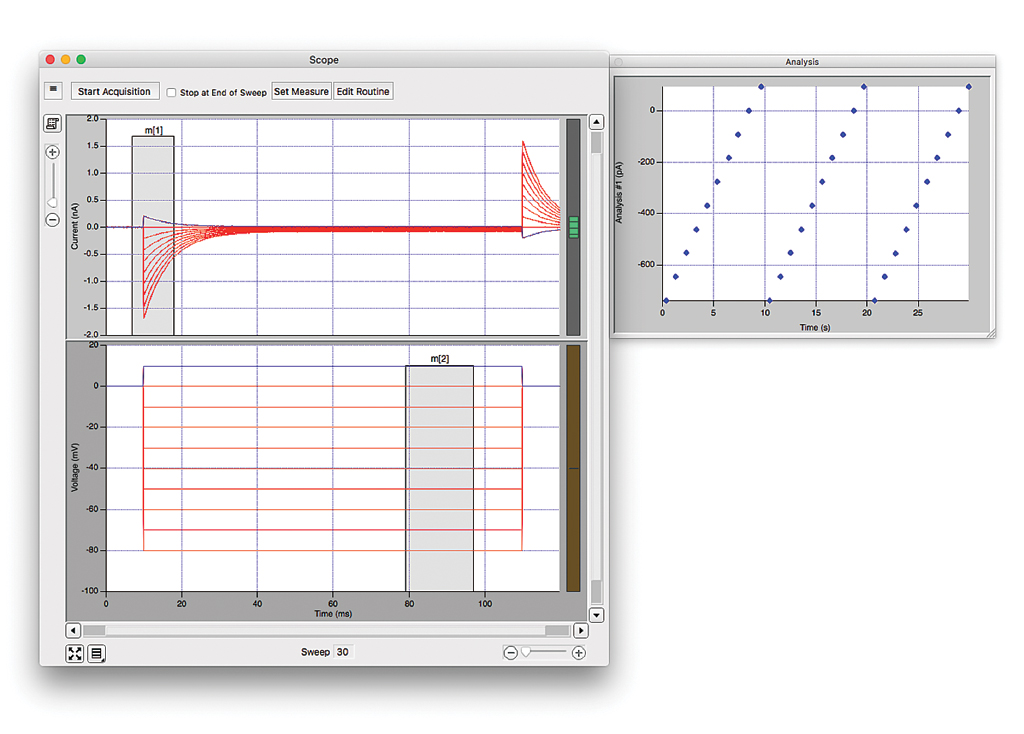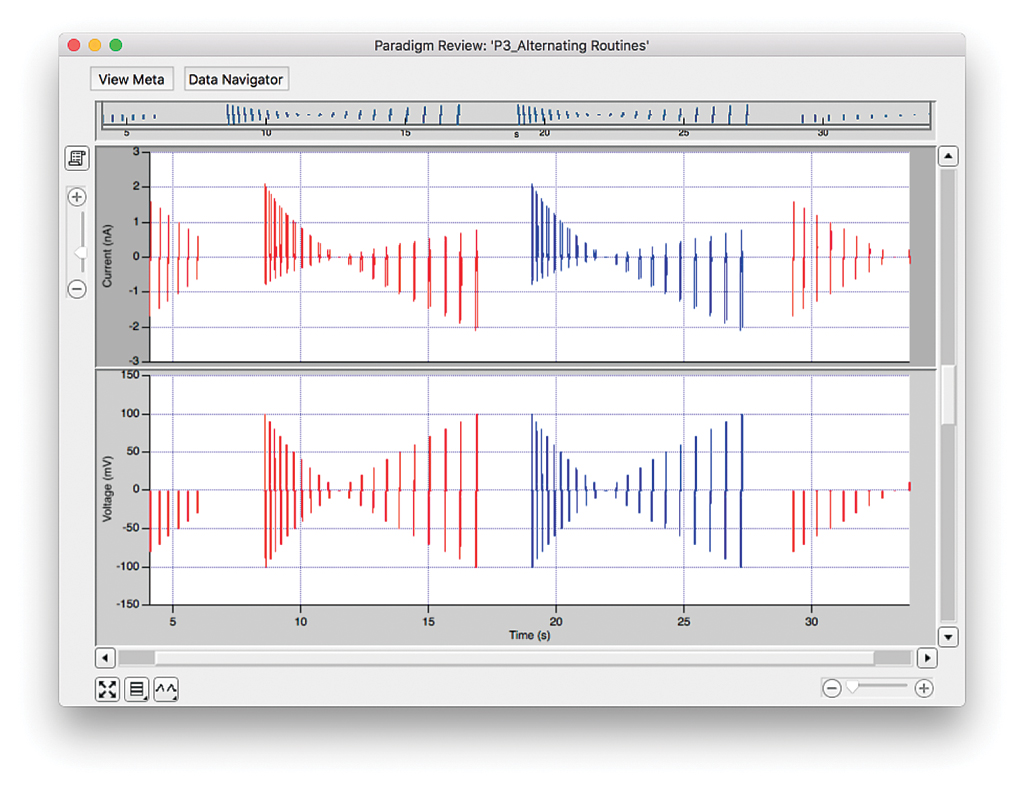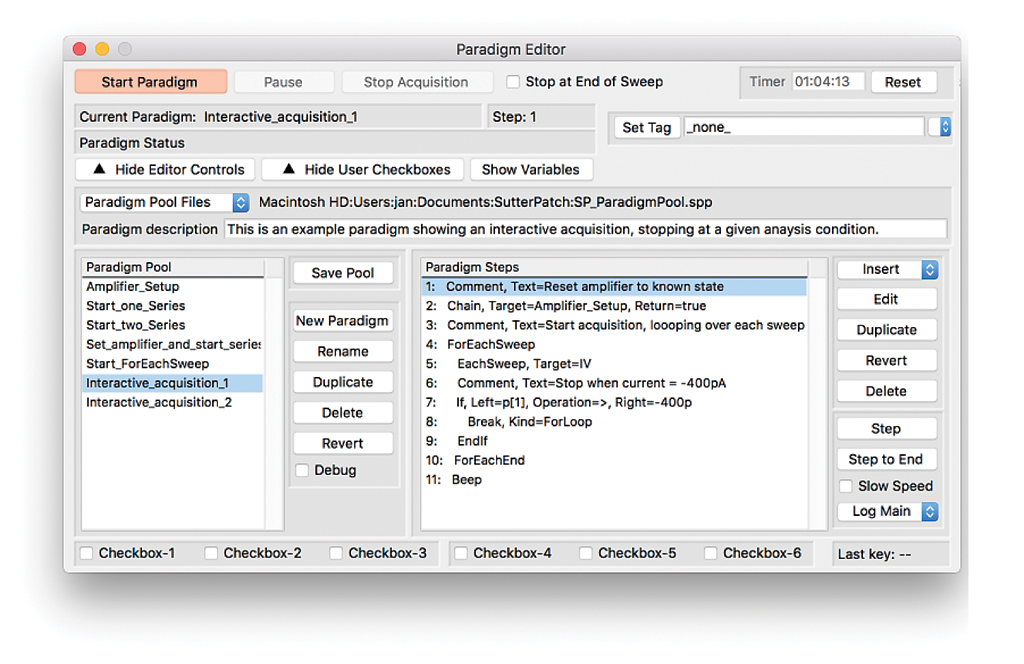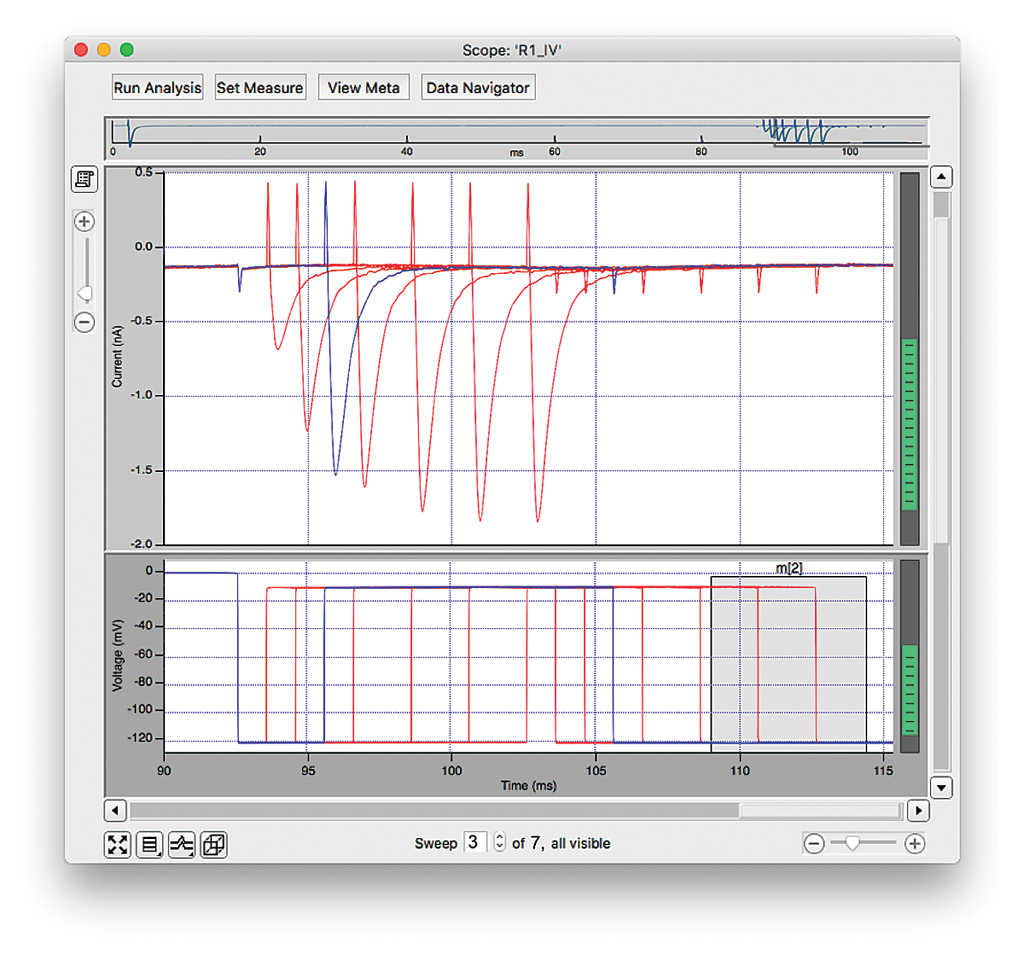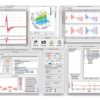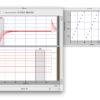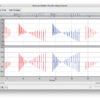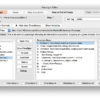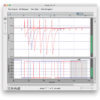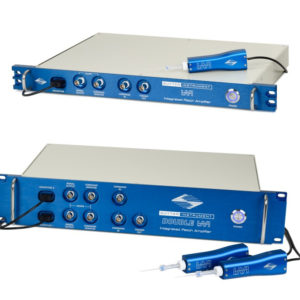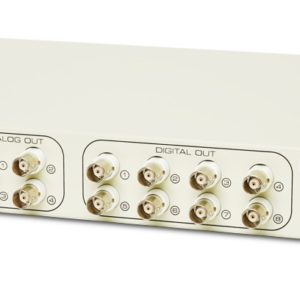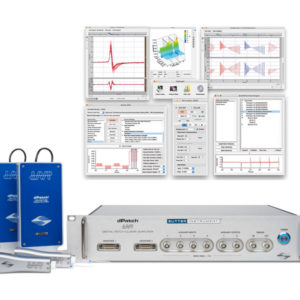SutterPatch®
Data Acquisition, Management and Analysis Software
SutterPatch® software is a full-featured electrophysiology data acquisition, management and analysis application for Windows or Mac OS computers. SutterPatch comes bundled with all Sutter Instrument Patch Clamp Amplifier Systems. The software controls data acquisition, provides real-time measurements to aid decision making during the experiment, keeps track of all amplifier parameters, records the experimental progress and stores a set of up to 600 metadata parameters. Built within the latest version of Igor Pro by WaveMetrics, Inc., SutterPatch provides immediate access to Igor’s powerful scientific and engineering analysis tools.
Product Enquiry
If you would like to send us an enquiry about this product, please click the button below, fill in the form and submit.
Product EnquirySutterPatch® software is a full-featured electrophysiology data acquisition, management and analysis application for Windows or Mac OS computers. SutterPatch comes bundled with all Sutter Instrument Patch Clamp Amplifier Systems. The software controls data acquisition, provides real-time measurements to aid decision making during the experiment, keeps track of all amplifier parameters, records the experimental progress and stores a set of up to 600 metadata parameters. Built within the latest version of Igor Pro by WaveMetrics, Inc., SutterPatch provides immediate access to Igor’s powerful scientific and engineering analysis tools.
Version 2 of SutterPatch electophysiology software adds support for the new dPatch® Digital Patch Amplifier System as well as a multitude of new features and user interface improvements that also apply to the IPA Family of Amplifier Systems. The Membrane Test and Free Run have been upgraded. New triple slider and 2D-matrix controls facilitate compensation adjustments in the Amplifier Control Panel.
Particular emphasis was put into intuitive navigation through large data sets. Controls that are familiar from electrophysiology software or applications in other fields, as well as entirely new approaches make finding a particular section of an experiment very easy.
The structured architecture of the data files was designed to retain the context of every sample within an experiment. With little effort at the beginning of an experiment, a plethora of metadata parameters are recorded – automatically where possible, configured by the user where desired. Each parameter can be reviewed before a Paradigm or Routine is executed.
SutterPatch software comes with a collection of sample Paradigms and Routines that facilitate the configuring of commonly executed experimental scenarios.
SutterPatch provides real-time analysis capability that automatically creates graphs like I-V curves or a time course plot while the experiment is in progress. Up to 8 analysis graphs can be shown, each derived from 16 possible measurements from the input signals. Analyses include mean, slope, rise time, frequency of threshold crossing, etc. This facilitates making decisions about the further course of an experiment.
In addition to real-time analysis, SutterPatch supports further processing after the experiment for the most sophisticated analysis procedures. SutterPatch adds application-specific capabilities on top of the expansive analysis feature set that is native to Igor Pro. Equations and Variables facilitate the use of more complex algorithms in both Routines and Paradigms.
SutterPatch® Features
- NEW: Support for for all Sutter Instrument Amplifier Systems, including the new dPatch® Digital Patch Clamp Recording System
- Scope Window provides intuitive, efficient navigation through your data
- Zoom control buttons and sliders
- Drag along axis to zoom in
- Mouse wheel zoom
- Marquee zoom
- Scroll bars
- Continuous and snapshot autoscale
- Sweep, time course and concatenated display
- Novel 3D display
- Unique Overview Navigator for panormaic examination of and convenient movement within a data section
- Paradigm Review window gives quick access to individual Routine Data
- Membrane Test keeps track of cell health and other quality control parameters
- Waveform types include double pulses, sine and triangle trains and instantaneous RMS noise measurement
- Simultaneous display of up to two amplifier or auxiliary input signals and a command waveform
- Test pulse parameters fully configurable
- Pulse averaging
- Audio monitor
- Routines control data acquisition with or without application of command waveforms
- Sample Routine Pool with pre-configured Paradigms for many common applications
- Records hard-wired signals from Sutter Instrument hardware and auxiliary input signals
- The command signal as applied to the cell is monitored and recorded
- Analog and digital output signals control periphery and third-party information
- Up to 50 Segments per Sweep for utmost flexibility in shaping the most complex command waveforms
- Preconfigured Segment shapes such as Sine, Square, and Chirp for easy waveform design
- Waveform Template enables “playback” of a recorded signal to a cell or applying a mathmatical expression as a waveform
- Measurements provide the basis for real-time analysis and enable decision making in the course of the experiment
- Paradigms enable process automation and eliminate operator bias
- Sample Paradigm Pool with pre-configured Paradigms for many common applications
- Configure the amplifier to reproducible standard settings
- Acquisition of Routine sequences enables pre-planned experimentation and minimizes operator bias
- Flow control for interactive or automated decision-making during the experiment
- Chaining Paradigms provides added flexibility
- Automatic creation of Layouts for standardized documentation
- The Solution Editor lets you keep track of solutions and compounds and supports direct control of a solution switcher
- Initial conditions and all solution changes are automatically written to the MetaData
- Analog or digital outputs control all common solution switchers
- The Data Navigator displays the entire experiment in a tree structure
- Preview of the first acquired signal
- Quick access to Paradigm Review, Reanalysis Scope, Metadata and Routine information
- Real-time and off-line analyses, including mini / synaptic event detection and action potential characterization
- Measurements configured as part of Routines create real-time graphs
- Virtual signals provide the user with information derived from physical input signals, mathematical equations, signal modification, or any combination thereof. High- and low-pass filters, lock-in amplifier capability, and subtraction of a reference sweep are new in version 2
- Paradigms can access measurements for further real-time analysis
- Equations and variables provide utmost flexibility
- Event detection using a performant, deconvolution-based algorithm
- Easily exports data to Microsoft Excel and other spreadsheet programs for compatibility with existing analysis procedures
- A wealth of native Igor Pro analysis features
- Support for IPA multi-amplifier mode
- Connect a combination of any two IPA® or Double IPA® amplifiers
- Supports up to 16 input channels
Dynamic Clamp – A New Feature in SutterPatch® Software and the dPatch® Digital Patch Clamp Amplifier
The dynamic clamp technique was first introduced in 1993 as a method for simulating ionic conductances in neurons during patch clamp recordings. This method typically involves recording the cell’s membrane potential, transmitting the data to a computer, calculating the appropriate current to be injected into the neuron, and sending this value back to the amplifier. Communication between the computer and amplifier limits the rate at which the dynamic clamp calculations can be updated. Moreover, the additional hardware and software needed to do dynamic clamp has limited its application. An all-in-one solution is now available as a free upgrade to SutterPatch software and the dPatch amplifier for researchers interested in performing dynamic clamp experiments.
The patented digital architecture of the dPatch amplifier system provides an ideal platform for dynamic clamp. The dPatch is powered by a system-on-chip which provides parallel processing across a Field Programmable Gate Array (FPGA) and two high-speed ARM core processors. Several sophisticated dynamic clamp models are implemented within this architecture. In each model, the update of the applied current values occurs without communication between the dPatch and a computer. Depending upon the complexity of the model, update rates of up to 500 kHz can be achieved.
Simulation of a population of channels within the neuronal membrane involves modeling the kinetics of the channel’s gating mechanisms. These channel kinetics can either be modeled using multiple independent gates as in the Hodgkin-Huxley model, or a multi-state Markov model. For Hodgkin-Huxley style models, the dPatch provides for up to 16 individual gates per simulated channel, with up to eight simulated channels running simultaneously per headstage. For Markov models, up to four 14-state models can be run simultaneously or eight models with fewer states can be run (e.g. eight 10-state models can run simultaneously).
The values derived from the gating equations are then used to calculate the current applied to the neuron. The calculation of current can either be defined in terms of conductance or permeability. For conductance models, the value defined from the gating calculations is combined with the reversal potential of the ions passing through the simulated channels, as well as the conductance of the simulated channels. Furthermore, channel conductance values can be voltage dependent. For permeability models, the value defined from the gating calculations is combined with the intracellular and extracellular concentrations of the ions passing through the simulated channels. These models simulate the Goldman-Hodgkin-Katz equations.
SutterPatch software is an intuitive, full featured data acquisition, management and analysis application designed to operate on Windows or Mac OS computers. SutterPatch comes bundled with the dPatch amplifier. The dynamic clamp user interface provides a powerful mechanism for loading dynamic clamp models. No expertise with scripting is required. Gate equations or Markov model transitions are simply entered as text and are interpreted by SutterPatch. Individual dynamic clamp models are saved in a pool and can be easily transferred between users. In addition, a number of sample models are provided to get users started, ranging from a simple leak conductance to a 12-state sodium channel.

Summary
- This free upgrade to SutterPatch software and the dPatch amplifier provides the first all-in-one solu tion for the researcher interested in performing dynamic clamp experiments.
- Fast dynamic clamp update rates result from the patented digital architecture of the dPatch amplifier.
- Supported models include:
- Hodgkin-Huxley style conductance models
- Goldman-Hodgkin-Katz style permeability models
- Markov models
- SutterPatch software control of dynamic clamp requires no scripting.
Download
SutterPatch Software comes as part of the IPA® Integrated Patch Amplifier and includes a license of Igor Pro 8 by WaveMetrics, Inc. The full installers available on this page include the Igor Pro 8 installer.
SutterPatch v2.0.4 (build 233); February 6th, 2020 – Release Notes
Windows Installers (Windows 7 or later, 64-bit)
Macintosh Installers (OS X 10.11 or newer)
Notes:
- We do not recommended using the SutterPatch Updater to install SutterPatch Software on top of an existing standalone installation of Igor Pro 8. If you already have Igor Pro 8 on your computer, please use one of the following methods to install SutterPatch Software:
- Use the Full Installer to update the existing Igor Pro 8 and install SutterPatch.
- Uninstall Igor Pro 8 and install SutterPatch using the Full Installer. Remember to backup your Igor user files before uninstalling!
- Create a second installation of Igor Pro 8 using the Full Installer. This should only be done in special cases and is not advised.
- SutterPatch is NOT compatible with Igor Pro version 6 or 7. Igor Pro 8, 64-bit is required. A single-user license of Igor Pro 8 comes bundled with SutterPatch Software. Contact Sutter Tech Support for upgrade information if you purchased your IPA Amplifier System with an Igor Pro 7 license before version 8 was available. See the System Requirements tab for the full list of hardware and software requirements.
- Igor Pro 8 and SutterPatch v.2 Software may be installed in addition to existing installations of older versions. All settings and parameters are independent between versions.
Software Trial
If you are planning to evaluate SutterPatch and Igor Pro 8, you can activate a trial license of Igor Pro. After 30 days, a number of features, such as saving, printing and copying to the clipboard will be disabled.
SYSTEM REQUIREMENTS
FOR IPA FAMILY SYSTEMS
Minimum Configuration:
- Operating System: Windows 10 (64-bit) or later, or MacOS: 10.11, El Capitan or later
- Processor: Dual-core i5
- Memory: 3 GB
- Hard Disk: 500 GB or greater
- Display Resolution: 1024 x 768 (XGA)
- 1 available USB 2.0 High Speed port
Recommended Configuration:
- Windows 10 (64-bit) or later, or MacOS: 10.11, El Capitan or later
- Processor: Dual-core i5
- Memory: 8 GB
- Solid-state drive (SSD): 500 GB or greater
- Display Resolution: 1920 x 1080 (FULL HD)
- 1 available USB 2.0 High Speed port
FOR dPATCH SYSTEMS
Minimum Configuration:
- Windows 10 (64-bit), or MacOS: 10.11, El Capitan or later
- Processor: Dual-core i5
- Memory: 6 GB
- Solid-state drive (SSD): 500 GB or greater
- Display Resolution: 1024 x 768 (XGA)
- 1 available USB 3.0 SuperSpeed port (on the main board, not a PCIx card or similar)
Recommended Configuration:
- Windows 10 (64-bit), or MacOS: 10.11, El Capitan or later
- Processor: Dual-core i5
- Memory: 16 GB
- Solid-state drive (SSD): 500 GB or greater
- Display resolution 1920 x 1080 (Full HD)
- 1 available USB 3.0 SuperSpeed port (on the main board, not a PCIx card or similar)
SUTTERPATCH® Data Acquisition Management System and Analysis Software: Included with all Sutter Instrument Amplifier Systems
Notes:
USB 3.0 ports are compatible with USB 2.0 High Speed specifications.
Slower USB 2.0 ‘full-speed’ ports, which are sometimes found on older Windows PCs or USB add-in cards, are not supported.
To check for High Speed USB 2.0 or USB 3.0 on a PC computer running Windows, look in the Control Panel > Device Manager > Universal Serial Bus controllers section for “Enhanced” host controllers. As this does not provide any mapping information to the computer’s physical ports, and there can be a mix of USB port versions, you should check individual USB ports for USB 2.0/3.0 High Speed operational performance. As a visual indicator, USB 3.0 ports are often color coded blue.
USB hubs are not supported. USB add-in cards, even if they formally meet High Speed or Super Speed specifications, are not recommended. They are often architecturally configured as USB hubs and may lead to intermittent transfer errors that are hard to troubleshoot.
Operating systems installed within virtualization software platforms such as VMware and Parallels are not supported.
